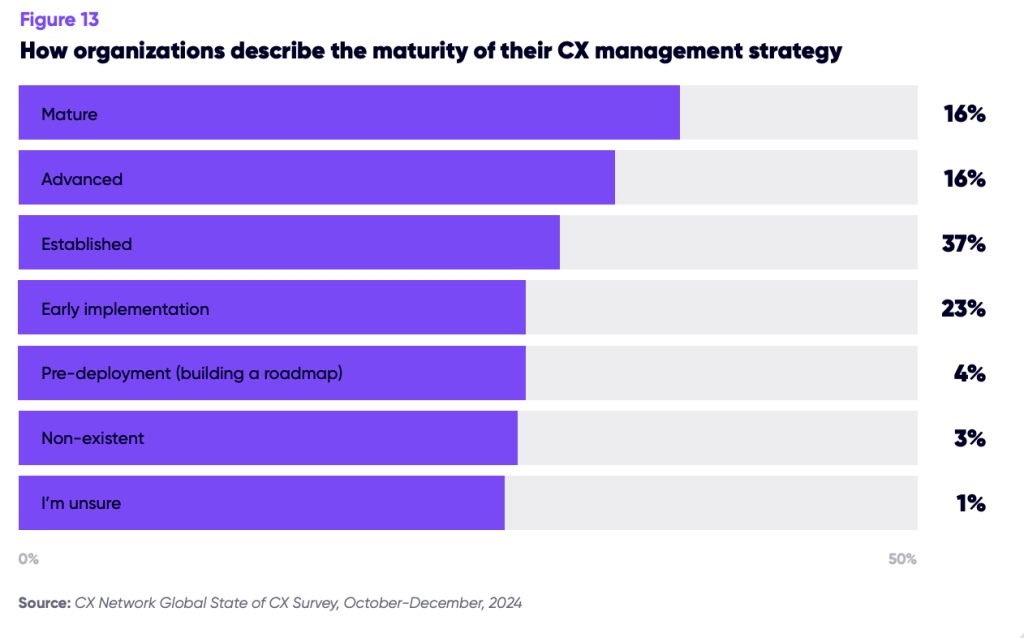9 Essential steps to CX maturity
Discover the many ways to measure CX maturity and a nine-step approach to achieving it
Add bookmark
Customer experience (CX) maturity is the road to customer centricity. It is the result of delivering a finely-tuned organization-wide CX strategy that considers customer and company needs to deliver measurable benefits and real results, including financial results.
There are many ways to measure CX maturity.
Special Report: The Global State of CX

Tenth annual flagship report. AI has transformed CX, raising expectations with investment in AI for CX automation, machine learning, and conversational AI now a top priority. Download the Global State of CX to learn how the industry is preparing for the new AI first future.
Download NowAccording to Qualtrics XM Institute there are six XM competencies and 20 XM skills on the road to CX maturity and, as organizations go about mastering the six competencies – lead, realize, activate, enlighten, respond and disrupt – they will evolve through five stages of maturity.
The Ipsos CX maturity assessment allows organizations to assess their own maturity then benchmark against others. The seven-part framework considers everything from strategy sponsorship to customer understanding, cultural enablement and ESG and prompts practitioners to ask themselves some big questions: What are the improvement areas in your organization that need to be addressed to achieve true customer centricity? Which ones are priority? And how do you go about tackling them?
In 2018, Gartner launched the CX Pyramid, a framework to understand what separates the most powerful customer experiences from the rest. Criteria includes how the experiences are triggered, the amount of effort required of the customer, the completeness of the solution, and the emotion and change in perception created by the experience.
There may be many ways to measure CX maturity, but the majority of practitioners still say their organization has some way to go to reaching maturity. Our 2025 research into the Global State of CX found only 16 percent of 353 practitioners consider their organization’s CX management strategy to be mature. A further 16 percent described their company's CX management strategy as “advanced”, while the majority (37 percent) reported that it is “established.”

A significant part of achieving maturity is down to organizational culture. During our Global State research we asked practitioners to select which statement best described their business culture. The largest share (30 percent) said they have seen wins from CX projects, which are helping to gain buy-in from various stakeholders. Only 12 percent said ‘CX underlines everything we do and is everybody’s responsibility’ and 20 percent said they are trusted to be more experimental due to historic CX gains.
How to achieve CX maturity
On how practitioners can advance from the realms of a CX strategy that is established to one that is mature, Rekha Weerasooriya, vice president of CX and people development for Dialog Axiata PLC and a CX Network Advisory Board member, says practitioners need to emphasize both traditional and digital CX as well as the importance of the user experience (UX) to embed CX as a core value.
She explains: “A mature CX management strategy will consist of a customer-centric organization where all functions are aligned towards delivering exceptional experiences. Analytics tools will enable real-time insights, driving decisions that meet customer needs proactively. A seamless customer journey across all touchpoints will be facilitated by an empowered workforce.
"Feedback loops will allow for continuous improvement, fostering customer trust. Technology, innovation and excellent UI/UX design will be core, providing personalized experiences that distinguish the company,” Weerasooriya adds.
Here is Weerasooriya’s nine-step approach to achieving maturity:
1. Adopt customer-centric culture: Align the company’s vision, values and goals with customer satisfaction. Regularly engage with customers for feedback and use it to drive continuous improvement and innovation.
2. Embed CX as a core value: Make CX a core value within the organization. Everyone, from top executives to frontline employees, should see CX as part of their job. By living this value daily, the organization will have a more unified purpose and stronger alignment toward customer satisfaction.
3. Integrate cross-functional teams: Foster collaboration among cross-functional teams. Having every department contribute to a seamless customer experience and effectively integrate customer insights back into these functions will help to continuously focus on improving experience.
4. Harness employee training and empowerment: Train employees at all levels to prioritize customer experience. Empower them with the tools and knowledge needed to resolve customer issues promptly and effectively.
5. Balance or deflect - traditional and digital CX: Ensure focus and plans for deflection from traditional to digital CX. While traditional CX includes in-person and phone interactions, digital CX involves online channels such as websites, social media, and mobile apps. Maintain consistent quality across all touchpoints.
6. Invest in technology and innovation: Leverage the latest technologies, such as artificial intelligence and machine learning, to automate and enhance customer interactions. Innovation in product offerings and services can also differentiate the company from competitors and provide better value to customers.
7. Integrate UI/UX in CX: Prioritize digital platforms' user interface (UI) and user experience (UX) design. A well-designed UI/UX enhances digital CX by making it easier for customers to navigate services, find information, and complete transactions, leading to higher satisfaction and loyalty.
8. Leverage advanced analytics: Invest in sophisticated analytics tools to gather and interpret vast amounts of customer data. Use these insights to personalize customer interactions, anticipate needs, and deliver proactive support across both traditional and digital channels.
9. Enhance customer journey mapping: While developing comprehensive customer journey maps to identify and optimize all touchpoints is desired in a business-as-usual setting, teams find it hard to spend time on this. However, this ensures consistent and positive experiences across traditional and digital channels, leading to higher customer satisfaction and loyalty.
Weerasooriya adds: “By focusing on these strategies, the company can achieve a mature CX management strategy, resulting in increased customer loyalty, reduced churn and sustainable business growth.”
Quick links
- Transforming complexity into growth: Solving what holds your business back
- CX Talks: Mastering the art of the possible
- 7 skills for CX teams: Mastering the balance of empathy, technology and data

































